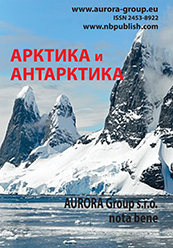Natural resources of the Arctic and Antarctica
Reference:
Tao, D., Alekseev , A.G., Brushkov, A.V. (2025). Long-term creep of frozen soils in multi-year tests. Arctic and Antarctica, 2, 1–14. https://doi.org/10.7256/2453-8922.2025.2.73912
Abstract:
This study focuses on the long-term creep behavior of frozen saline soils (sand, silty, loam) under constant temperature and mechanical loading conditions. The frozen soil samples were collected in situ from modern marine and alluvial Quaternary deposits on the Yamal Peninsula. Special attention is given to the temporal deformation dynamics under uniaxial compression. The research aims to identify patterns in deformation rate changes, analyze both primary (transient) and secondary (steady-state) creep stages, and compare experimental results with theoretical models of aging, hardening, and flow behavior. Experiments were conducted during 9 years in the underground laboratory of the Amderma Permafrost Station at a depth of 14 meters, which enabled investigation into the long-term mechanical behavior of frozen soils. The findings are of significant importance for predicting the stability of building foundations in permafrost regions and for preventing structural failures. The research method involved prolonged laboratory testing of frozen soil specimens using uniaxial compression under constant temperature and stress conditions. The scientific novelty of this study lies in the unprecedented duration of the experiments (to 9 years), which far exceeds the time frames of most previously conducted creep tests. In most existing studies, the maximum duration of creep testing for frozen soils in various conditions did not exceed several months. For the first time over such an extended time span, it has been shown that sands and silty exhibit a transition from unstable to stable deformation stages, whereas loams demonstrate nonlinear behavior, presumably due to crack formation and internal structural changes. The application of mathematical modeling enabled refinement of deformation prediction parameters, which is of practical significance for engineering calculations. The obtained results enhance the reliability of foundation stability assessments and provide a scientific basis for the design of buildings and infrastructure in permafrost regions.
Keywords:
structure, admerminskaya underground laboratory, engineering geocryology, permafrost, deformation, long-term testing, theory, uniaxial compression, creep of frozen soils, damped creep
 This work is licensed under a Creative Commons Attribution-NonCommercial 4.0 International License.
This work is licensed under a Creative Commons Attribution-NonCommercial 4.0 International License.











 © 1998 – 2025 Nota Bene. Publishing Technologies. NB-Media Ltd.
© 1998 – 2025 Nota Bene. Publishing Technologies. NB-Media Ltd.




